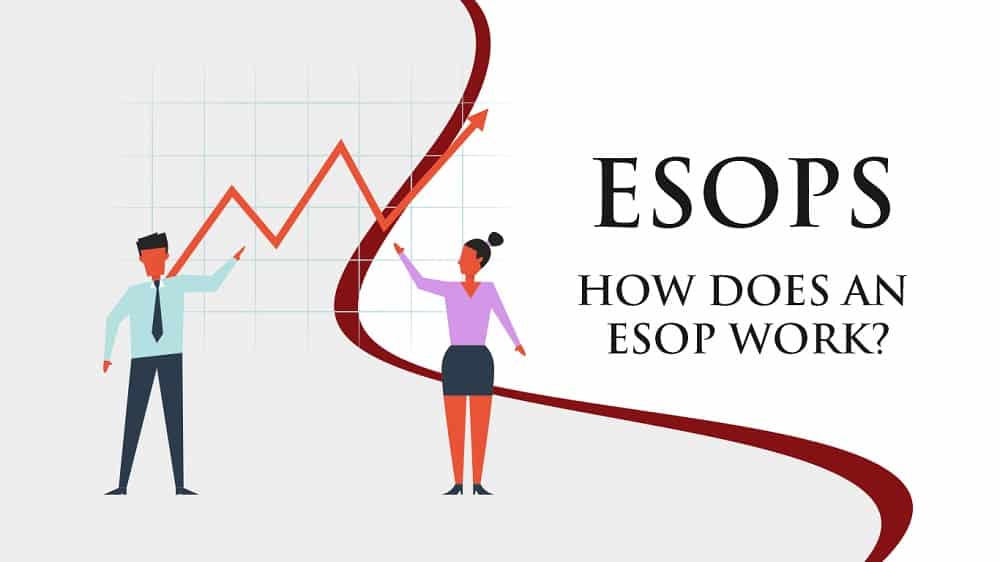The National Center for Employee Ownership (NCEO) estimates that there will be around 6,600 employee stock ownership plans (ESOPs) encompassing more than 14 million participants by the end of 2021. There has been a decrease in the number of plans but a rise in the number of participants since the turn of the century. There are also approximately 3,800 profit sharing and (to a much smaller extent) stock bonus programs that are heavily invested in company shares and, in other ways, are similar to ESOPs. So, one may ask: how does this employee stock ownership plan work? In this article, we’ll learn how an employee stock ownership plan (ESOP) works, the benefit, tax advantages, and disadvantages. We’ll also look at an example of this employee stock ownership plan.
What is an ESOP (Employee Stock Ownership Plan)?
An Employee Stock Ownership Plan (ESOP) is a type of employee benefit plan in which employees own a portion of the company. So, at no cost, the employer assigns a set percentage of the company’s equity shares to each eligible employee. Shares may be distributed based on the employee’s salary scale, periods of service, or some other basis of allocation.
Employee stock ownership plan shares are retained in a trust unit for safety and growth until the employee leaves the company or retires. After they leave, the company buys back their shares and returns them to the corporation for further distribution to other employees.
An Employee Stock Ownership Plan invests in the company of the employer. The plan’s purpose is to align employees’ interests with the interests of the company’s shareholders. Employees transform from mere employees to owners of the company when they have a stake in the company. Employees are encouraged to perform what is best for the shareholders since they are also stockholders.
Employee-owned corporations, which are comparable to worker cooperatives, are companies with a majority of employee ownership. So, the distinction between an employee stock ownership plan and a worker corporation is that an ESOP does not share the company’s capital fairly. Senior employees have more shares than fresh employees, so the latter have less voting power at shareholder meetings.
How does Employee Stock Ownership Plan Work?

When a firm decides to establish an Employee Stock Ownership Plan, it must first establish a trust to which it will donate either new shares of the company’s stock or cash to purchase existing stock. Contributions to the trust are tax-deductible up to a specified amount. The shares are subsequently assigned to each employee’s account. So, the most typical allocation formula is based on pay, years of service, or both. After at least one year of service, new workers typically join the plan and begin receiving allocations.
Employee shares in an ESOP must vest before employees are eligible to receive them. In this example, vesting refers to the rising rights that employees obtain on their shares as they advance in the firm.
Employees who are members of the ESOP should receive their equity when they leave the company. Within 60 days of the employee’s leave, private enterprises need to buy back the departing employee’s shares at fair market value. To calculate the price of the shares, private firms must conduct an annual stock valuation. When some long-term employees leave the company and the share price has risen significantly, the corporation must ensure that it has enough funds to cover all share repurchases.
The Advantages of an ESOP
#1. Employee Tax Benefits
One of the advantages of Employee Stock Ownership Plans is the tax advantage that employees receive. Employees do not have to pay taxes on their contributions to an ESOP. Employees are only taxed when they get a dividend from their ESOP after retirement or when they leave the company in any other way. Capital gains are taxed as they increase over time. If they want to take cash distributions before reaching the standard retirement age, they must pay a 10% penalty.
#2. Increased employee involvement
Employee engagement and involvement are higher in companies that have an ESOP in place. It raises employee awareness by giving them the ability to influence product and service decisions. Employees can view the big picture of the organization’s future objectives and offer recommendations on the type of direction the company should take. An ESOP also boosts employee confidence in the company.
#3. Positive results for the company
Employee stock ownership programs not only help employees but also benefit the company. According to the National ESOP Comparison Study undertaken by Rutgers University, the use of ESOPs resulted in a 2.4 percent rise in yearly sales growth, a 2.3 percent increase in annual employment growth, and an enhanced likelihood of company survival. Improved organizational performance raises the company’s share price and, as a result, the balance in each employee’s ESOP account.
Disadvantages of an ESOP
#1. Insufficiency of variety
Employees who participate in an ESOP pool their retirement resources in a single business. This lack of diversity goes against the investing theory tenet that recommends investors to invest in a variety of companies, industries, and regions. Worse, the employees invest their money in the same corporation that pays their salary, wages, insurance, and other benefits. If the company goes bankrupt, the employee risks losing both their income and their savings. Employees at Enron and WorldCom, for example, lost the majority of their retirement savings when their companies went bankrupt.
#2. Restriction on newer workers
An Employee Stock Ownership Plan is structure is in such a way that benefits are for newer employees. Employees who registered in the plan earlier benefit from the plan’s continuing contribution, which gives them more voting power. This is not the case for fresher employees, who, even insecure organizations, may not accrue as many savings as long-term employees. As a result, newer employees have fewer opportunities to participate in important decisions during annual general meetings and other forums.
#3. Dilutive
Share ownership in an Employee Stock Ownership Plan is dilutive, which means that each share’s percentage of ownership is smaller. As new employees join the company, shares are assigned to their accounts in the plan. This reduces the aggregate percentages of shares held by older plan members. The dilution also affects voting power, because employees who have a lot of voting power because they have a lot of shares end up with less voting power after they permit new members. Let’s look at an example of the employee stock ownership plan.
Example of Major Employee Stock Ownership Plan (ESOP)
ESOPs can be found in businesses of all sizes. Some of the more well-known majority employee-owned businesses include Publix Super Markets (200,000 employees), Amsted Industries (18,000 employees), and W.L. Gore and Associates (Gore-Tex manufacturer, 10,720 people) and Davey Tree Expert (10,500 employees) (see our Employee Ownership 100 list). Year after year, companies with ESOPs and other broad-based employee ownership plans account for considerably more than half of Fortune Magazine’s “100 Best Companies to Work for in America” list.
Frequently Asked Questions
How Does Employee Stock Ownership Plan Work?
To begin, an employee stock ownership plan is established as a trust fund. Companies can put freshly issued shares here, borrow money to buy business shares, or finance the trust with cash to buy company shares. Meanwhile, employees are given the right to a rising number of shares, which increase over time depending on the length of their employment. These shares are sold when an employee retires or is terminated, and the employee receives the cash value of their shares.
What is an employee stock ownership plan (ESOP)?
An employee stock ownership plan (ESOP) provides employees with business equity, typically based on the length of their employment. Typically, it is part of a remuneration package in which shares vest over time.
What is an example of an Employee Stock Ownership Plan?
Consider a five-year employee at a prominent technology company. They have the right to obtain 20 shares after the first year, and 100 shares overall after five years, under the company’s employee stock ownership plan. When the employee retires, they will receive the cash value of their shares.
Conclusion
An ESOP may provide tremendous benefits to selling shareholders, management teams, and employees. The federal laws governing ESOPs, on the other hand, are complex, and the expense of creating and maintaining a plan may be higher than for other forms of retirement plans. As a result, it is necessary to speak with advisers who are familiar with the legal, accounting, and administrative challenges that are particular to ESOPs. Creating and managing an ESOP can be difficult. However, with a continual emphasis on educating members and advice from experienced professionals, the benefits of an ESOP typically outweigh the obstacles.
- INITIAL PUBLIC OFFERING (IPO) PROCESS: Detailed Guide!
- Payroll Software for Small Business: 5 Best Free Payroll Software
- Payroll Report: Detailed Guide to Payroll Report
- GRANT DEED: Best US Practices & All you should Know
- Payroll Software: 10 Best Payroll Software for Businesses
- What is an ESOP: Explained, Distribution, Plan, Company, Difference, & Payout






